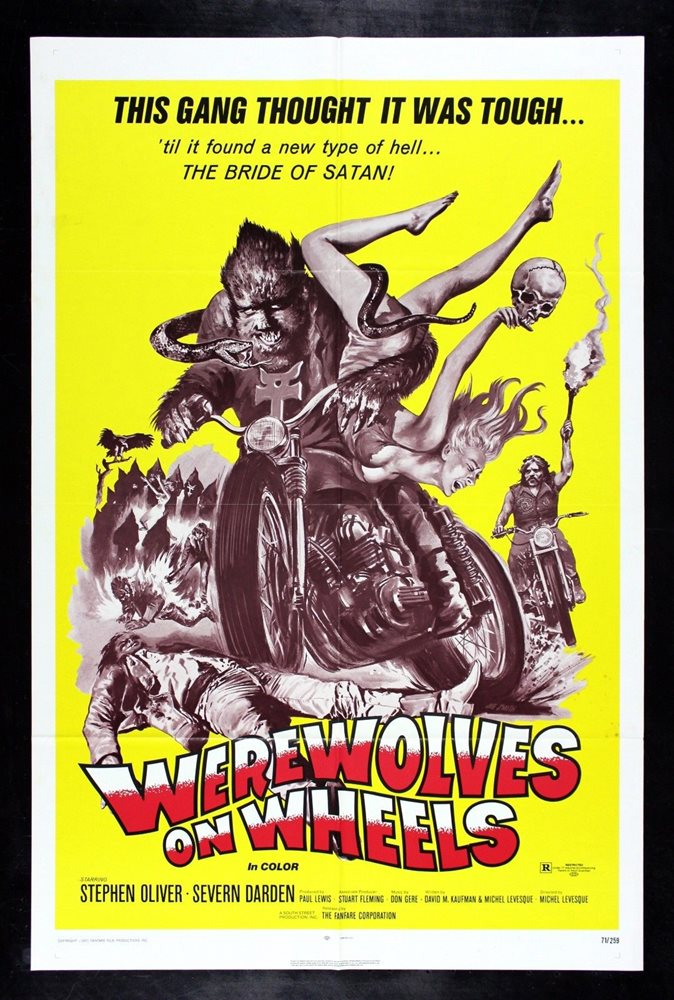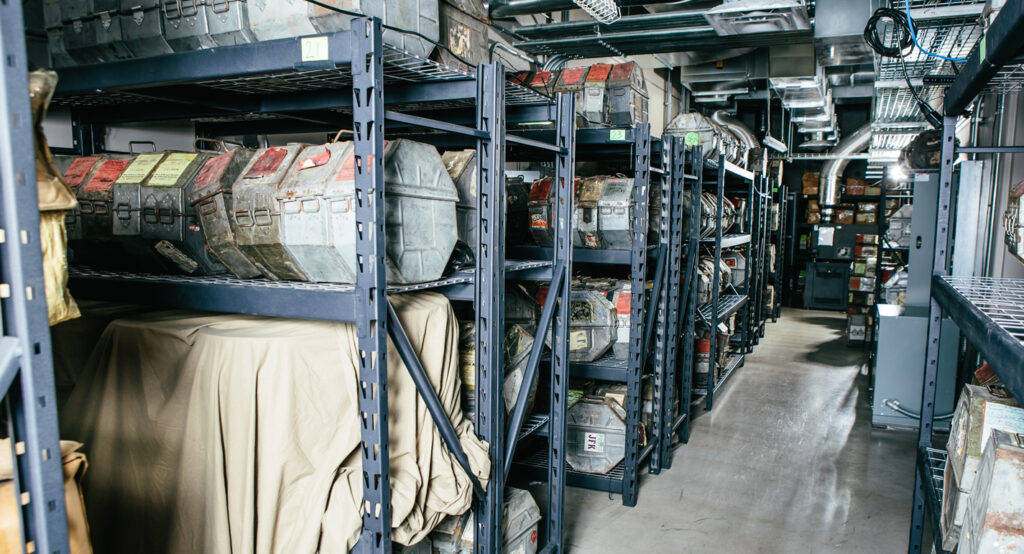‘Warped & Faded’: New Book Tells How Weird Wednesday Led to the Birth of the American Genre Film Archive [Interview]

Warped & Faded showcases all of the forgotten movies rescued by the Alamo Drafthouse that were screened during the early years of the Weird Wednesday film series. In addition to a 200-page B-movie compendium, the book, written by Lars Nilsen and friends and edited by Kier-La Janisse, tells the story of how the beloved screening series helped launch the American Genre Film Archive.
Now a nationwide dine-in theater chain, the original Alamo Drafthouse location at 4th and Colorado in Austin, Texas was home to a dedicated film geek community that was passionate about the obscure drive-in treasures overlooked over the years. Back in 1999, theater owner Tim League famously drove a U-Haul out to East Prairie, Missouri to rescue a huge number of forgotten film prints. Those beat-up reels became the backbone of the Weird Wednesday collection. Films like 1977’s water Nazi zombie gem Shockwaves and the satanic biker gang picture Werewolves on Wheels were shown to mouth-agape patrons every week. Because of the poor quality and degradation of all or most of the prints, everyone got in for free. Just be sure to tip the waitstaff, order a beer if you’re willing and help spread the word.

Adding to the fun, the human film encyclopedias known as Lars Nilsen and Zack Carlson would introduce each film with a surprising amount of unbridled enthusiasm. Lars would do the write-ups for Weird Wednesday to help get butts in seats and Zack would focus on what eventually became Terror Thursday. “Zack and I had sort of like a battle of write-ups. We were sort of competing a little bit to have the best write up every week,” Nilsen recalls. “We both have high powered writing styles that are different but at the same time, we really value our ability to kind of make the movie sound incredible just in our write-ups.”
Living in Austin at the time, I remember reading these descriptions of films I’d mostly never heard of. Can these guys possibly love these movies this much? Speaking with Lars, he clarified the issue. “It’s not a review, it’s ballyhoo.” It was okay to talk the movie up a bit, especially when a lot of these films were virtually unknown at the time. “When you’re writing ballyhoo,” Nilsen continued, “which is an old word by the way, you’re really unleashed. You’re off the chain. Your only real goal is to make people show up. And then people come and they’re disappointed because then you’ve lost your credibility. You really are upping the ante but you better not be bluffing too often.”
Most of the time, the films you saw on Weird Wednesday were legitimately mind blowing. Continuing our conversation below, Nilsen went on to speak about more of his memories about the Drafthouse and how the eye-popping images in Warped & Faded are taken from the actual original 35mm prints (now stored at AGFA). He also recalled one of his favorite encounters with director Stephanie Rothman (Blood Bath, The Working Girls) that perfectly highlights how these underappreciated filmmakers have finally found an audience that truly appreciates them.
Dread Central: I was surprised to find out from the book that you had never been a programmer before. I would think that getting up on stage and introducing these films to what eventually became a sold out crowd must’ve been a little nerve racking.
Lars Nilsen: In those days, I would get pretty high. I would be a little stoned or even a lot stoned sometimes. It took a little bit of the edge off and allowed me to feel more free. Then I just learned some tricks. I still introduce a lot of movies. I program for Austin Film Society and I introduce movies like crazy. All the time. You do it enough, I think you learn a couple of things. The audience is on your side, which once you figure that out, it takes so much of the heat off. If you make a mistake, they’re feeling it too. They’re on your team. That’s huge. And also, the trick to write a couple of jokes so that you have something funny in your pocket. Whether you use those jokes or not, it gives you a sort of comfort level when you go up and introduce the film if you know you could make the audience laugh if you absolutely had to.
DC: That’s good advice. The layout of the book is fantastic. The movie posters are so vibrant that it almost feels like a pop-up book.
LN: Yeah, and it’s a no bullshit layout, too. It’s not like anything’s like canted angles or anything like that. It’s really cool the way that it’s sort of brought in. One thing I really love is that in addition to just having posters and stills, we also sat down with the film prints. We hauled those film prints over to AGFA and we went through and did the full page frame blowups from some of the films. So that, in a lot of the book you see just gigantic full page frame blowups with all the damage that’s in the print. So you can see just how wrecked some of these prints are. We talk a lot about the sort of ragged glory of what these films look like on the big screen. We’re showing you direct evidence by actual screen grabs from the actual prints that we played. You can really sort of appreciate and enjoy, I think, just how shitty some of these film prints actually look.
DC: Talk about the whole process of going from Weird Wednesday to preserving all the prints and, now, AGFA is worldwide. It’s pretty amazing.
LN: Sometimes people give me credit for AGFA and being part of that which I’ll take a little bit of it. What I really helped to build was a gigantic pile of prints on the floor. Then a lot of the other people like Justin Ismael and especially Sebastian del Castillo and Joe Ziemba and all the people that came in and helped to put it together to make it an active working archive. We had just been grabbing prints wherever they were. It was kind of a golden age to acquire prints because people were getting rid of these prints. People didn’t know what these movies were. There was no interest. Even from other kind of hip-ish film outlets, DVD companies or theaters, they just weren’t interested in these particular movies, for the most part. They were interested in other stuff. Generally stuff that was a little more highbrow. We really were able to accumulate a great deal of film, sometimes for ten to thirty dollars per print.
DC: Wow.
LN: And I’m so glad we did because it was going to become much more difficult later. A lot of those same film prints, now, if you do find them on the market, they’re four or five hundred bucks each. The people that were attracted to Drafthouse, people who were attracted to the Weird Wednesday and Terror Tuesday series, those people ended up being some really talented dedicated people. That was sort of the next step. Taking that pile of films and actually doing an unimaginable amount of work to build an archive of film prints that is catalogued and eventually begin digitizing those and getting those out in DCP format to any theater that really wants to book them.

DC: Why focus on just Weird Wednesday and not Terror Thursday as well? Have you considered doing another horror-focused companion?
LN: Terror Thursday didn’t come around for a number of years so it wouldn’t have been covering the same sort of wild west period. That would really be up to Tim and Kier-la and maybe Zack if they wanted to do that. It’s a little bit down the road from this stuff and it’s quite a bit different. Really, I think part of the impetus was wanting to talk about the very early days of Drafthouse and the way this community came together. And the organic growth of going from a community of weird people to something that has structure and that has status in the world. And, in a way I think, probably to show people who are maybe interested in making their mark on the world – and of having their weird taste matter and have value in the world – to show those people that we were every bit as stoned and as stupid as you are right now. And we did it. And we didn’t do it because we were geniuses, we did it because we stuck with it and because we cared and because we had the conviction of our passion.
DC: It’s a textbook case of finding your people. This isn’t just an encyclopedia of drive-in movies. It’s also a record showing how much appreciation we all have and you all have for the underappreciated actors and directors. I was wondering if you had some favorite encounters with these filmmakers when you were able to meet them and let them know these films aren’t forgotten.
LN: I think one of the most special moments was with Stephanie Rothman who made all these movies – and these weren’t the movies she would have made had she had her druthers. Had she had any choice in the world, she would not have made a women in prison movie and a sexy nurse movie. And she was very, I think, raw about that. When she came to the theater to show her movies, I think there was really a great moment where she realized, okay, the audience knows that these aren’t the movies that I would’ve made if I could’ve made some different kinds of movies. But they appreciated the touch that I brought to it. She went from, really frankly a nervous wreck before the screenings, to just so light-hearted and happy after the screenings. Because she felt like whatever was in there that was her had communicated to this audience. I don’t know if she was ever at peace with that before that screening. That’s one that really stands out to me, out of many.
Warped & Faded: Weird Wednesday and the Birth of the American Genre Film Archive is available now on MondoShop.com.
Categorized:Interviews News
